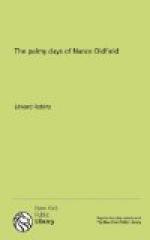“Hor. Look, my Lord, it comes!
“Ham. Angels and ministers of grace defend us! Be thou a spirit of health, or goblin damn’d; Bring with thee airs from heav’n, or blasts from hell; Be thy events wicked or charitable; Thou com’st in such a questionable shape That I will speak to thee. I’ll call thee Hamlet, King, Father, Royal Dane. Oh I answer me. Let me not burst in ignorance; but tell Why thy canoniz’d bones, hearsed in death, Have burst their cerements? Why the sepulchre, Wherein we saw thee quietly inurn’d, Hath op’d his ponderous and marble jaws To cast thee up again? What may this mean? That thou dead corse again in complete steel Revisit’st thus the glimpses of the moon, Making night hideous?”
I do not therefore find fault with the artifices above mentioned, when they are introduced with skill and accompanied by proportionable sentiments and expressions in the writings.
For the moving of pity our principal machine is the handkerchief; and indeed in our common tragedies we should not know very often that the persons are in distress by anything they say, if they did not from time to time apply their handkerchiefs to their eyes. Far be it from me to think of banishing this instrument of sorrow from the stage; I know a tragedy could not subsist without it: all that I would contend for is to keep it from being misapplied. In a word, I would have the actor’s tongue sympathise with his eyes.
A disconsolate mother, with a child in her hand, has frequently drawn compassion from the audience, and has therefore gained a place in several tragedies. A modern writer, that observed how this had took in other plays, being resolved to double the distress, and melt his audience twice as much as those before him had done, brought a princess upon the stage with a little boy in one hand and a girl in the other. This too had a very good effect. A third poet being resolved to outwrite all his predecessors, a few years ago introduced three children with great success: and, as I am informed, a young gentleman, who is fully determined to break the most obdurate hearts, has a tragedy by him where the first person that appears upon the stage is an afflicted widow in her mourning weeds, with half a dozen fatherless children attending her, like those that usually hang about the figure of Charity. Thus several incidents that are beautiful in a good writer become ridiculous by falling into the hands of a bad one.




